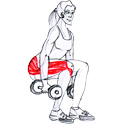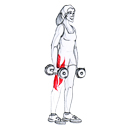-

|
-

|
| Step 1 |
Step 2 |
- Targeted Muscles:
- Hamstring
- Quadriceps
- Buttocks (gluteus maximus)
- Additional Muscles:
- Hip Flexors
- Inner Thighs (adductors)
- To focus the exercise more on your inner thighs and buttocks, place your feet roughly double shoulder width apart.
- If you find squatting with dumbbells difficult or if you do not have weights handy, you can simply place your hands on your hips or straight out in front of you to help maintain your balance while you squat.
- Slowing down your movements can make the exercise harder and increase muscular and tendon strength. To slow down your movements, you can take 4 seconds to get down into the squat, pause at the bottom for 2 seconds and then take 4 seconds to get back up. This technique can be performed with or without weights.
- The dumbbell squat works most of the muscles in your lower body, including your quadriceps, hamstrings, buttocks, hip flexors and inner thighs. This is an excellent exercise for developing strong, well-toned legs, which can make many everyday activities, such as walking, climbing stairs or lifting things off the ground, easier to perform.
- If you have trouble maintaining your balance while squatting, try to keep your head up, look straight ahead and focus on an object directly in front of you instead of looking down, you will be more likely to lose your balance and fall forward.
- To improve your form, you can place a bench behind you and then lightly touch the bench with your buttocks each time you squat. As you come out of the squat, concentrate on pushing yourself up through your heels rather than the balls of your feet.
- Do not shift your body weight forward and allow your heels to lift off the floor.
- Do not hunch or excessively arch your back.
- Do not lift your head up or down. Keep your head and neck in line with your back
- Do not lock your knees.
|











